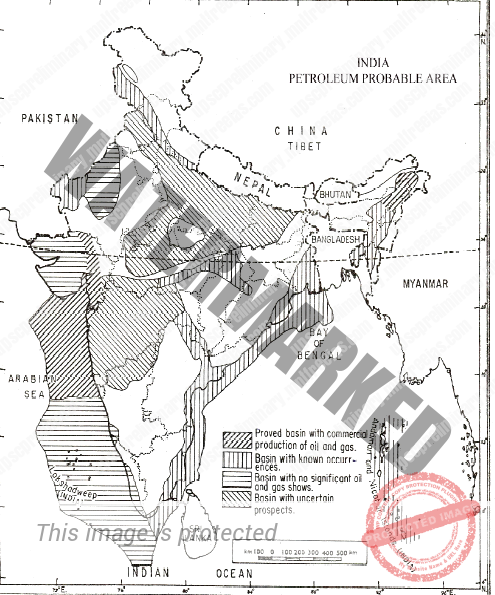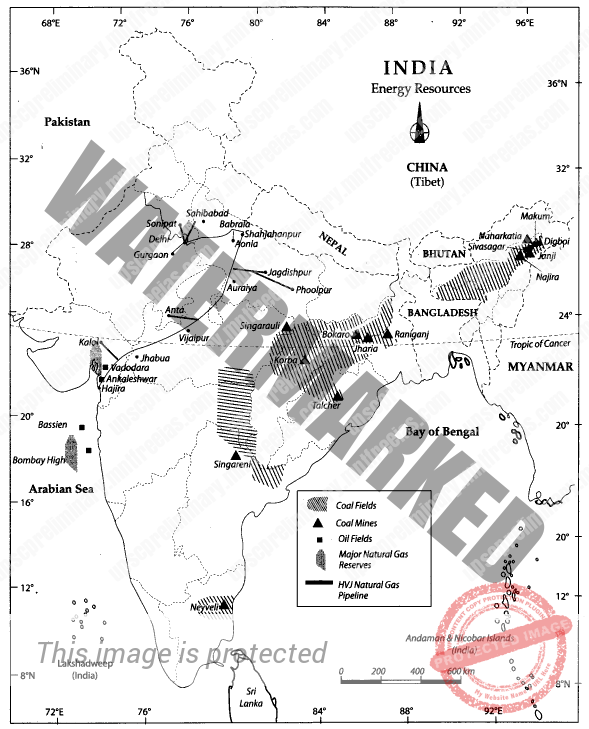- PETROLEUM OR MINERAL OIL
- PETROLEUM RESERVES OF THE WORLD
- OIL REFINERIES IN INDIA
- NATURAL GAS
- ATOMIC MINERALS
UNIT 6 – MINERALS AND RESOURCES – PART 7
Petroleum or Mineral Oil:
Petroleum is most widely used energy source after coal in India. it is also called as liquid gold sitting its importance in modern world. Our agriculture, industry and transport system depend on petroleum in several ways. It found under the surface of earth in solid, liquid and Vapour form.
- Solid form – Asphalt
- liquid form – crude oil
- Vapour Form – Natural Gas.
Petroleum occurs in anticlines and fault traps. In India it is found in passes of sedimentary rocks. When these rocks are drilled Natural Gas comes out first followed by petroleum. Petrol, kerosene, diesel, detergents, synthetic fibres, plastics, cosmetics etc. are important products derived from petroleum.
Petroleum Reserves of the World:
60% of World’s oil resources are in West Asia or middle East. Saudi Arabia, Iran, Iraq and Kuwait have largest reserves of petroleum. Latin American state Venezuela also have huge amount of petroleum reserves.
Iraq is the India’s highest supplier of Crude Oil.
India’s Petroleum reserves:
Most of petroleum reserve areas lie in the Assam, Gujarat, and offshore areas along the western coast.
The entire production of India till today comes from the Assam belt, Gujarat- Cambay belt and Bombay High (63% Production is from Mumbai High, 18% from Gujarat and 16% from Assam).
The Assam belt consist of Dihang basin, Bhitra and Surma Valley. The Gujarat-Cambay belt extends from Mehsana (Gujarat) in the north to the continental shelf off
the coast right up to Ratnagiri (Maharashtra) in the south. It covers Bombay High which is the largest producer of petroleum in the country.
In Assam, the oil producing area is located in the Lakhimpur and Sibsagar districts.
Oil Refineries in India
The crude petroleum taken from oil fields needs to be refined before it can be used.
Oil refining is really a big chemical engineering industry involving a complicated process. Presently there are 17 oil refineries in India under public sector.
These oil refineries are supplied crude oil either by ships or by pipelines.
Although the annual production shows an increasing trend, the country has to import petroleum and petroleum products to meet its requirements.
Natural Gas
Natural gas is in association with or without petroleum. It is emerging as an important source of commercial energy. It is used as a source of energy as well as an Industrial raw material in the petrochemical Industry. Natural Gas is preferable over petroleum as its low carbon dioxide emission.
USA has the largest reserves of Natural Gas.
In India Natural Gas reserves are found in Krishna Godavari basin, Gulf of Bombay, Andaman- Nicobar, etc.,
Gas Authority of India was established in the year 1984 with an aim for processing, transporting, distributing, and marketing of natural gas. The company owns and operates a network of over 5,340 km of natural gas pipeline in the country.
Atomic minerals:
Atomic energy is obtained by altering the structure of atoms. Heavy metals like Uranium, Thorium, Radium, Plutonium and lithium are the main sources of Nuclear Energy. Currently 11% of World’s energy need satisfied by nuclear energy.
India possesses the world’s largest reserves of monazite, the principal source of thorium and some reserves of uranium. Australia has the highest deposits of Uranium in the world followed by Kazakhstan.
Uranium is also called as ‘Yellow Cake’ |
Uranium deposits in India:
India produces 2% of world’s Uranium. In India, uranium is embedded in the igneous and metamorphic rocks in Jharkhand, Rajasthan, Andhra Pradesh, and some parts of Himalaya.
A substantial source of uranium deposits is also found in the monazite sands along the Kerala coasts and in some parts of Bihar. The production of uranium at present is confined to the mines at Jaduguda in Singhbhum district of Jharkhand. The total reserves of uranium in the country are enough to support 5-10 Gw of electricity generating capacity.
Thorium deposits in India:
Thorium is principally obtained from monazite. The beach sands of Kerala contain the world’s richest monazite deposits. It also occurs on the sands of Visakhapatnam in Andhra Pradesh, Tamil nadu, Rajasthan, Jharkhand, Bihar.


